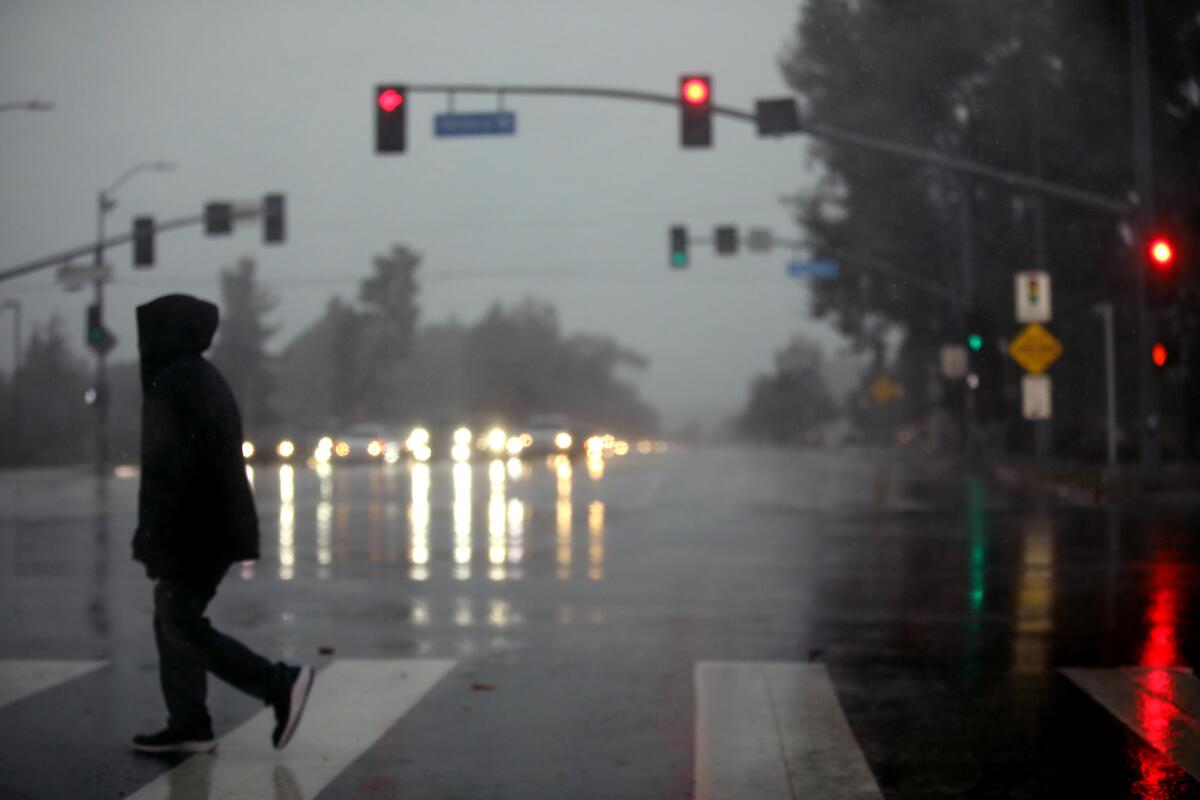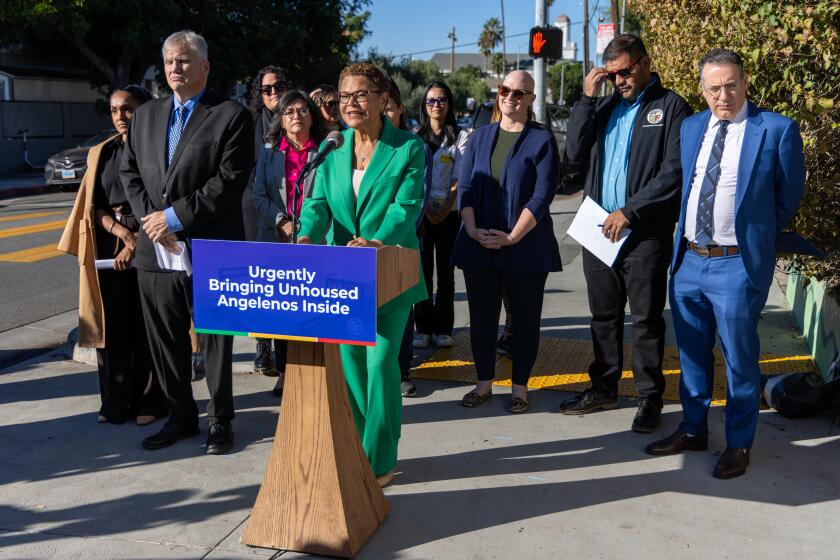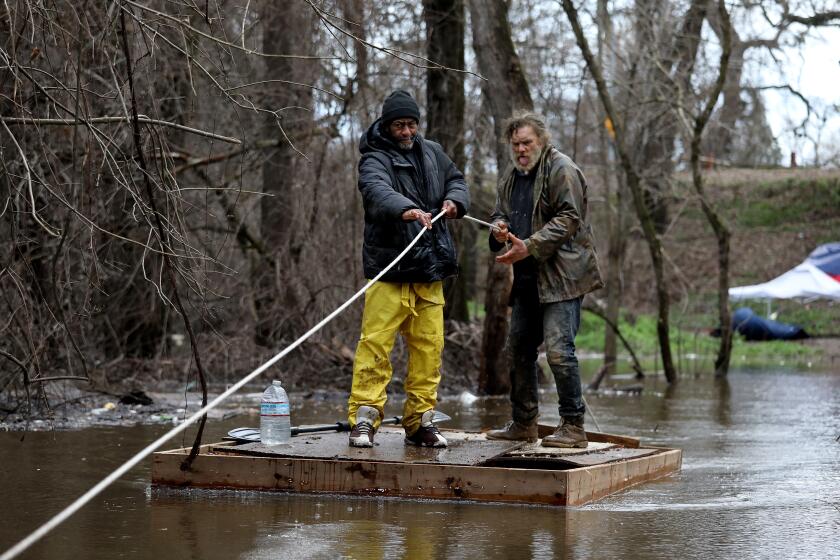Why storms like this one will make solving homelessness even harder for L.A.

- Share via
Ask James Valdez, and he’ll tell you a harrowing story about the last time it rained.
This month, he was headed back to the tiny home where he has lived for the last year, tucked away in a gated village for the unhoused, on a forgotten stretch of concrete between railroad tracks and numerous recycling centers in Sun Valley.
But Valdez couldn’t get in.
For days, water had been falling from the sky in record-breaking amounts, extreme weather that scientists say will become all the more common with climate change. Now trash, debris and other nastier stuff from dozens of dilapidated RVs had washed down San Fernando Road and were blocking the gate to the village.
A storm is brewing for Southern California over Presidents Day weekend, the National Weather Service says. Storms are expected in the San Francisco Bay Area too.
A small river had formed. Tiny homes flooded. Eventually, most of the village’s 140 or so residents had to be evacuated to emergency congregant shelters.
“I tried to see if I could walk along like the railroad tracks to get in. But by time I got closer to the door, the water was up to here on me,” Valdez recounted, pointing to his knee and shaking his head in disbelief.
To be clear, what happened in Sun Valley this month didn’t happen to every tiny home village. Indeed, most of the ones that increasingly dot Los Angeles seemed to come through the last round of atmospheric rivers just fine — unlike, say, those multimillion-dollar mansions in Dana Point that are slowly sliding into the Pacific Ocean.
But with a future certain to be filled with extreme weather, the experiences of Valdez raise questions about how climate change could put new pressures on the efforts to solve homelessness in Los Angeles. It might be time for a reassessment.
For example, should some forms of interim housing be prioritized over others to shelter people during days-long deluges? What about protecting them from extreme heat? Should air conditioning come standard?
What about how sites are selected for tiny homes? Should more weight be given to the safety of unhoused residents than to the objections of potential neighbors? Is it really a good idea to be housing people in an industrial area next to railroad tracks that was never designed for long-term residents?
And what about cost versus speed? Homelessness is a massive problem, but there’s still only so much money that can be spent to solve it. Tiny homes are faster and cheaper to build, helping people to get off the streets quickly. But in a future altered by climate change, are they better than, say, motel rooms, which are more expensive and take longer to acquire?
These are questions that even Mayor Karen Bass has been considering to some extent.
When I asked her about the people who were forced to evacuate from Sun Valley, she told me that “it’s now going to make us go out and assess the tiny home villages and some of the other interim housing.”
And also that it creates an “urgency” to come up with different models for interim housing.
This is the “urgency” that city officials in Sacramento faced in 2022, when a storm dumped so much rain that it set a one-day record and flooded a recently sanctioned encampment near a freeway underpass. A steady stream of passing vehicles splashing water onto the tents made the situation worse, and many of the homeless residents ended up having to relocate to higher ground or to an emergency shelter.
Mayor Karen Bass talks about the thousands she’s moved into interim housing. But it’s the removal of encampments that will make Angelenos believe it.
“We just have to get more creative,” Bass said. “I mean, this is the U.S. We put people on the moon. We can’t figure out quickly manufactured housing?”
Adding to the pressure to get it right, while taking the dangers of climate change adequately into account, is that whatever interim housing is built, is not really going to be interim. Permanent housing is so scarce that people are likely to be living in tiny homes or motel rooms for 18 months to two years.
Bass calls it “long-term interim housing.”
Valdez says it’s better than being on the streets, even with a sudden river running through his tiny home village.
“We got flooded out, but they still took care of us and took us to a safe place and even took us to get showers. We’ve been blessed,” he told me. “It’s better than being in a tent and in the rain, and getting flooded. Yeah, at least you got a place to somewhat call your home.”
Randall Gibbs, another resident of the Sun Valley village, agreed, even as he talked about hearing waves slosh against the metal exterior of the tiny home he shares with another man and two dogs.
With more rain forecast for this week, the team managing the village, all from Volunteers of America-Los Angeles, say they are ready and there should be no more flooding.
Valdez, Gibbs and the other residents were allowed to return to their bunks in their tiny homes last week after the floodwaters receded, and after the city had cleared much of the debris blocking the fence and storm drains.
Going forward, what Rosa Govea, area assisting director with VOA-L.A., would like to see is consistent maintenance of those drains and cleanups of trash from the encampments farther up San Fernando Road.
With storms battering Northern California, the dozens who live in tents on Bannon Island are among the most at risk.
“You know, make sure that we prevent some of the things that are preventable?” she said.
On Thursday afternoon, delivery trucks and cars zigzagged around unidentifiable heaps of twisted metal and fabric left in the street, as trains roared by and a helicopter circled overhead. Govea pointed out cleanup work that still had to be done, a few feet from the village’s imposing fence and guard shack.
Orlando Ward, executive director of external affairs for VOA-L.A., said the safety assessments of the tiny home villages it manages will continue. The dangers of extreme weather have become very apparent, very quickly.
“When I was out here, we were in cardboard boxes,” he said of years he spent living on Skid Row. “And this would’ve been absolutely tragic, having the rains come like this. It didn’t rain like that 25 years ago.”
More to Read
Sign up for Essential California
The most important California stories and recommendations in your inbox every morning.
You may occasionally receive promotional content from the Los Angeles Times.















